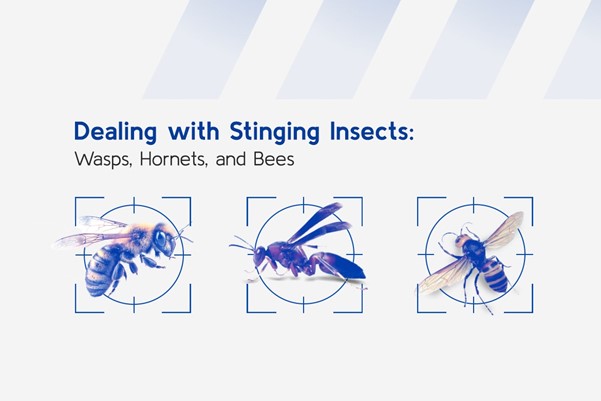Stinging insects such as wasps, hornets, and bees are a common concern for homeowners in Singapore. With their presence often signalled by a sudden and painful sting, understanding these insects is crucial for both safety and effective management. While these insects are essential to the environment, contributing to pollination and controlling other pests, their potential to cause harm requires careful handling.
In Singapore’s tropical climate, the active presence of these stinging insects can lead to infestations if not properly managed. Each type of stinging insect—wasps, hornets, and bees—has distinct behaviours and nesting habits that influence how they interact with humans and their environment. Knowing these differences helps in taking appropriate precautions and actions to avoid unpleasant encounters.
At MET Pest Control, we bring extensive expertise and experience to the management of stinging insects. Our team is trained to identify the specific type of stinging insect, assess the severity of infestations, and implement safe and effective solutions. Whether you’re dealing with a small nest in your garden or a larger infestation around your property, MET Pest Control provides professional, reliable service to protect your home and ensure your safety.
The Differences Between Wasps, Hornets, and Bees
Before you address a stinging insect problem, it’s essential to understand the different types of insects you might encounter. Wasps, hornets, and bees each have distinct characteristics, behaviours, and roles within their ecosystems. Knowing how to differentiate between these insects can help you determine the best approach to manage them effectively and safely. This section will provide insights into their physical traits, behaviours, and common habitats to help you identify which insects you’re dealing with.
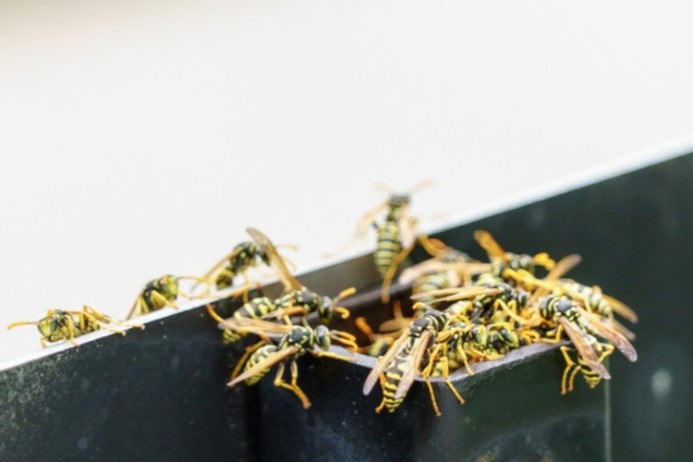
Wasps
Wasps are easily recognized by their slender bodies, smooth skin, and narrow waists. Unlike bees, which have fuzzy bodies, wasps have a more streamlined appearance. Their bodies are typically a bright yellow with black stripes, and they have a smooth exoskeleton, which makes them look more streamlined and less hairy compared to bees.
Wasps are known for their aggressive nature, particularly when their nests are disturbed. They build papery nests from a material they create by chewing wood fibres mixed with their saliva. These nests are often found in sheltered locations such as eaves, attics, or hidden within wall voids. In Singapore, you might find them in areas like garden sheds or under the eaves of buildings. Wasps are more likely to sting multiple times if provoked, making them particularly hazardous.
In Singapore’s urban and garden settings, wasps can be found nesting in places like tree branches, under roof eaves, and sometimes even in man-made structures like ventilation ducts. They are attracted to food and sugary drinks, making outdoor dining areas a common site for encounters.
Hornets
Hornets are essentially a type of wasp but are larger and generally more aggressive. They can grow up to 2 inches in length, making them more noticeable and intimidating compared to the smaller wasps. Hornets have a more robust and rounder body compared to the slender wasps.
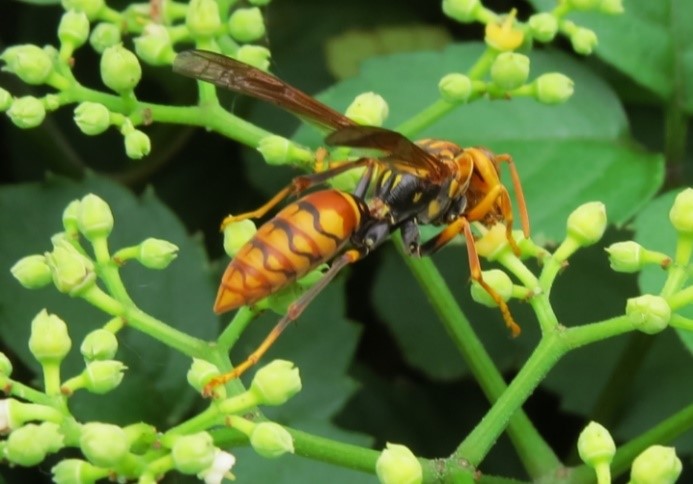
Hornets build large, spherical nests that are often found in trees, shrubs, or under eaves. These nests are made from a paper-like substance, like wasps, but they are much larger and can house hundreds of hornets. Hornets are known for their painful stings and can sting multiple times. Their aggression tends to increase when their nest is threatened, making it essential to handle any infestations with caution.
In Singapore, hornet nests can often be spotted in tall trees or dense shrubbery. They may also build nests in less visible areas such as under eaves or in the attic spaces of buildings. Due to their size and aggressive nature, hornet infestations should be addressed promptly to avoid dangerous encounters.
Bees
Bees are distinguished by their fuzzy bodies, which are covered in tiny hairs that help them collect pollen. They have a more robust and round appearance compared to wasps and hornets. Bees are typically more docile and less aggressive, only stinging when they feel truly threatened.
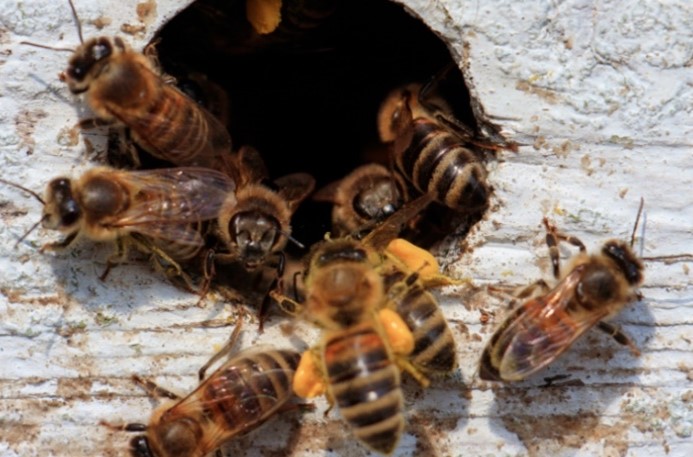
Bees play a crucial role in pollination, which is vital for the reproduction of many plants and flowers. This process supports biodiversity and contributes to the overall health of the ecosystem. By transferring pollen from one flower to another, bees help in the growth of fruits, vegetables, and wildflowers.
In Singapore, bees are often found in gardens, parks, and urban green spaces. They are attracted to flowering plants and are commonly seen buzzing around flowering bushes and trees. Bee nests can sometimes be found in wall voids or in tree branches. While bees are less likely to pose a threat compared to wasps and hornets, it’s important to avoid disturbing their nests, especially if they are located near human activity areas.
Understanding these differences helps in addressing any issues with stinging insects appropriately and safely. For effective management and to handle infestations properly, consulting with professionals like MET Pest Control ensures a safe and effective solution.
Safety Tips for Dealing with Stinging Insects
Encountering stinging insects like wasps, hornets, or bees can be unsettling. Understanding how to handle these situations safely is crucial to avoiding painful stings and potential allergic reactions. Here are some essential safety tips to follow when dealing with stinging insects:
Stay Calm and Avoid Sudden Movements
If you find yourself near stinging insects, it’s vital to stay calm. Panicking or making sudden movements can provoke these insects and increase the risk of being stung. Aggressive behaviour, like swatting at them, may be interpreted as a threat, leading to defensive stinging.
Take slow, deep breaths and move away from the area calmly and deliberately. Avoid flailing your arms or making erratic movements that could attract attention. A composed approach reduces the likelihood of attracting or agitating the insects.
Keep a Safe Distance
Understanding where stinging insects are likely to build their nests helps in avoiding them. Wasps and hornets often construct their nests in sheltered spots like eaves, attics, or trees. Bees may build nests in hollow spaces or tree branches.
If you spot a nest, keep a safe distance and avoid disturbing it. Alert others to steer clear of the area to minimize the risk of accidental encounters. If you need to work near an area where you suspect a nest might be, exercise caution and be observant of any insect activity.
Avoid Perfumes and Bright Clothing
Fragrances and bright colours can attract stinging insects, as they are drawn to sweet scents and vibrant hues. Perfumes, scented lotions, or brightly coloured clothing can make you more noticeable to these insects, increasing the likelihood of an aggressive response.
When spending time outdoors, opt for unscented personal care products and wear neutral-coloured clothing. Avoid brightly coloured fabrics and floral prints that might attract attention from stinging insects.
Know When to Call for Help
If you discover a nest of stinging insects on your property, especially if it’s in a location that poses a risk to people, it’s best to contact professionals like MET Pest Control. Professional pest control services have the expertise and equipment to safely and effectively manage and remove nests.
If you have a large or aggressive infestation, or if the nest is located at a challenging or hazardous area, it’s crucial to seek professional assistance. Attempting to remove a nest on your own can be dangerous and lead to serious injuries or allergic reactions.
By following these safety tips, you can reduce the risk of stinging insect encounters and ensure a safer environment for yourself and others. If you suspect a stinging insect problem or need assistance with nest removal, MET Pest Control is here to help with expert advice and effective solutions.
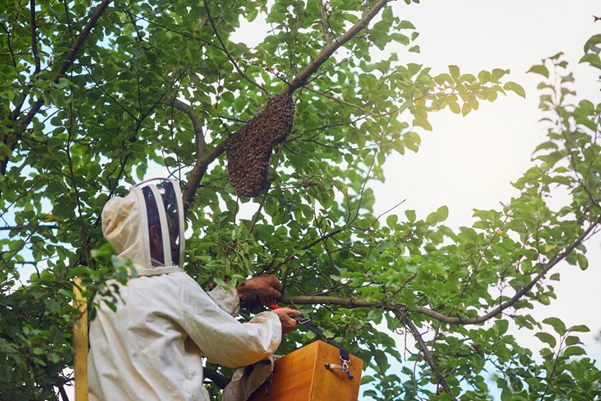
Don’t wait for stinging insects to become a problem!
For insect solutions and expert advice
What to Do if You’re Stung: Immediate and Emergency Care
Getting stung by a wasp, hornet, or bee can be an alarming experience. Understanding the appropriate steps to take can help alleviate pain, reduce the risk of complications, and ensure your safety. Here’s a guide on how to handle a sting and when to seek medical help.
Immediate Steps to Take
Getting stung by a wasp, hornet, or bee can be a painful experience. Knowing how to respond promptly and correctly can alleviate discomfort and prevent complications. In this section, we’ll guide you through the immediate actions you should take following a sting, including how to address the pain and reduce the risk of infection or allergic reactions.
Remove the Stinger (If Stung by a Bee)
- Bee Stings: Bees can leave their stinger embedded in your skin, which may continue to release venom. To remove the stinger, use a pair of tweezers or the edge of a credit card to gently scrape it out. Avoid using your fingers or tweezers to pinch the stinger, as this may release more venom.
- Wasps and Hornets: These insects do not leave their stingers behind, so there is no need for removal.
Clean the Area
- Washing: Use mild soap and water to clean the sting site thoroughly. This helps prevent infection and removes any residual venom.
- Disinfecting: Apply an antiseptic to the area to further reduce the risk of infection.
Apply Ice to Reduce Swelling
- Ice Pack: Place an ice pack or a cold compress on the sting site for about 10-15 minutes. This helps to numb the area, reduce swelling, and alleviate pain. If you don’t have an ice pack, a cloth dampened with cold water can also be effective.
Take Antihistamines if Needed
- Managing Allergic Reactions: Over-the-counter antihistamines can help control itching and swelling. Follow the dosage instructions on the package and consult a healthcare professional if you have any concerns or if you are unsure which antihistamine to use.
When to Seek Medical Attention
While most insect stings result in minor pain and discomfort, some can trigger severe allergic reactions. It’s crucial to recognize the signs that require urgent medical attention. This section will outline the symptoms of serious allergic reactions and provide guidance on when to seek professional medical help to ensure your safety and well-being.
Signs of Severe Allergic Reactions (Anaphylaxis)
- Symptoms: Watch for symptoms of a severe allergic reaction, such as difficulty breathing, swelling of the face or throat, hives, rapid heartbeat, dizziness, or a drop in blood pressure.
- Emergency Action: If any of these symptoms occur, seek emergency medical help immediately. Anaphylaxis is a serious condition that requires prompt treatment with an epinephrine injection and professional medical care.
When to See a Doctor for Other Concerns
- Persistent Pain or Swelling: If the pain or swelling worsens or does not improve after a few days, consult a healthcare provider. They can evaluate the sting site for potential infections or other complications.
- Signs of Infection: If you notice increased redness, warmth, or pus at the sting site, or if you develop a fever, it may indicate an infection that requires medical treatment.
By following these steps, you can effectively manage a sting and reduce the risk of severe reactions. If you encounter a stinging insect problem or need professional help with removal, MET Pest Control offers expert services to address your concerns and ensure a safer environment.
How MET Pest Control Safely Manages Stinging Insects
Dealing with stinging insects such as wasps, hornets, and bees requires expertise and precision to ensure safety and effectiveness. MET Pest Control specializes in managing these pests with a comprehensive approach that includes inspection, safe nest removal, and preventive measures. Here’s how our professionals handle stinging insect issues to protect your home and health.
Inspection and Identification
Effective pest management begins with accurate identification. Understanding the type of insect and assessing the extent of the infestation are critical steps in addressing the problem safely. Here, we’ll explain how professionals inspect and identify stinging insects to determine the best course of action for removal and prevention.
Thorough Inspection
- Initial Assessment: MET Pest Control experts start with a detailed inspection of your property to locate nests and identify signs of infestation. This involves checking common nesting sites such as eaves, attics, wall voids, and outdoor areas.
- Identification: We identify the type of stinging insect present, as different species require different approaches. For instance, hornets and wasps might nest in different locations and exhibit varied behaviours compared to bees.
Severity Evaluation
- Extent of Infestation: Our professionals assess the severity of the infestation, including the size of the nest and the level of activity around it. This helps in planning an effective treatment strategy.
Safe Nest Removal
Removing a nest of stinging insects can be dangerous and requires careful handling. Professionals use specialized methods to ensure the safe removal of nests from residential or commercial areas. This section will describe the procedures used to safely eliminate nests and prevent the insects from returning.
Specialized Equipment and Techniques
- Protective Gear: Our technicians use specialized protective clothing and equipment to ensure their safety during the nest removal process.
- Effective Removal Methods: Depending on the location and type of nest, we use various methods such as chemical treatments, physical removal, or a combination of both. For example, for ground nests, we may use dust or liquid insecticides to eliminate the insects, while aerial nests may require different techniques.
Professional Approach
- Minimizing Disruption: We work carefully to minimize disturbance to the surrounding area and reduce the risk of agitating the insects. This includes timing the removal to coincide with lower insect activity periods.
- Complete Removal: Our goal is to ensure that the entire nest is removed and that no remaining insects pose a risk.
Preventive Measures
Once an infestation is addressed, preventing future problems is key to maintaining a pest-free environment. This section will cover the preventive measures that can be implemented to avoid future stinging insect issues, including tips and strategies to keep your home or business safe.
Addressing Attractants
- Eliminating Food Sources: We provide advice on how to eliminate food sources and other attractants that might draw stinging insects to your property. This includes tips on proper waste management and food storage.
Sealing Entry Points
- Preventing Re-Infestation MET Pest Control offers solutions for sealing entry points and potential nesting sites to prevent future infestations. This might involve repairing damaged areas, installing screens, or using other exclusion methods.
Ongoing Monitoring
- Regular Inspections: We recommend periodic inspections to monitor for any signs of returning pests and to address any new issues promptly.
- Client Education: We educate clients on how to recognize early signs of stinging insect activity and how to act if they suspect a problem.
By employing a thorough and professional approach, MET Pest Control ensures that stinging insect issues are effectively managed and that your home remains safe and comfortable. If you’re dealing with a stinging insect problem or need preventive advice, contact MET Pest Control for expert assistance and tailored solutions.
Why Professional Help Is Necessary
When it comes to dealing with stinging insects like wasps, hornets, and bees, the risks associated with DIY solutions and the benefits of professional services are significant. Understanding these factors is crucial for ensuring your safety and effectively managing infestations. Here’s why professional help from MET Pest Control is the best approach for handling stinging insects.
Risks of DIY Solutions
Many homeowners consider DIY methods for pest control, but these approaches can sometimes exacerbate the problem or lead to personal harm. In this section, we’ll discuss the risks associated with DIY pest control solutions and why relying on professional services is often the safer and more effective choice.
Safety Hazards
- Increased Risk of Stings: Attempting to remove nests on your own can expose you to multiple stings, especially if the insects feel threatened. Wasps and hornets can sting repeatedly, leading to severe allergic reactions or infections.
- Inadequate Protection: DIY methods often involve inadequate protective gear, increasing the risk of injury. Without proper equipment and knowledge, you may accidentally aggravate the insects or disturb the nest, escalating the situation.
Ineffectiveness of Over-the-Counter Products
- Limited Reach: Many over-the-counter pests control products are designed for surface use and may not effectively penetrate or eliminate the nest, leaving behind active insects.
- Improper Application: Without professional training, applying these products incorrectly can lead to incomplete eradication of the infestation. This can result in ongoing pest issues and potentially larger infestations.
Property Damage
- Risk of Damage: DIY removal methods, especially those involving sprays or other chemicals, can inadvertently damage your property. Misapplication can harm surfaces or cause unwanted residues, necessitating additional cleanup or repairs.
Benefits of Professional Services
Professional pest control services offer numerous advantages over DIY methods, including expertise, equipment, and comprehensive solutions. This section will highlight the benefits of hiring professionals for stinging insect management and how they can ensure effective and safe treatment for your pest problems.
Expertise and Experience
- Specialized Knowledge: MET Pest Control’s experts have extensive knowledge about different types of stinging insects and their behaviours. This expertise ensures that the appropriate methods and treatments are used for each specific situation.
- Effective Treatment: Our professionals employ advanced techniques and equipment to safely and effectively remove nests and eliminate stinging insects. We are equipped to handle complex infestations that might be beyond the scope of DIY methods.
Safety and Efficiency
- Comprehensive Safety Measures: MET Pest Control uses specialized protective gear and follows strict safety protocols to ensure that the removal process is conducted safely for both the technicians and the property occupants.
- Targeted Solutions: We utilize targeted treatments that penetrate nests and reach hidden insect populations, ensuring complete eradication and reducing the risk of future infestations.
Long-Term Results and Prevention
- Thorough Inspection: Beyond removal, our services include a detailed inspection of your property to identify potential entry points and nesting sites. This helps in preventing future issues.
- Preventive Measures: MET Pest Control offers advice and solutions for preventing stinging insects from returning. This includes sealing entry points, eliminating attractants, and scheduling follow-up inspections if necessary.
Peace of Mind
- Professional Assurance: By choosing MET Pest Control, you benefit from professional assurance that the infestation will be managed effectively and that your home will be protected from stinging insects. Our goal is to provide a safe and pest-free environment for you and your family.

Don’t wait for stinging insects to become a problem!
For insect solutions and expert advice
Conclusion
Understanding the differences between wasps, hornets, and bees is crucial for effective management and ensuring safety. While these stinging insects play different roles in the ecosystem, they can pose significant risks if they become a nuisance or threaten your home. Wasps are aggressive and build papery nests, hornets are larger and more aggressive with the ability to sting multiple times, and bees, despite their beneficial role in pollination, can become problematic if their nests are located near human activity. Effective management and safety measures are essential when dealing with these insects. Attempting to handle stinging insects without professional help can lead to increased risks of stings and ineffective treatments. Therefore, relying on professional pest control services ensures not only safe removal but also effective prevention of future infestations.
If you’re dealing with stinging insects or want to prevent potential issues, don’t hesitate to reach out to MET Pest Control for expert assistance. Our team of professionals is equipped to handle wasps, hornets, and bees with the utmost care and precision, ensuring a safe environment for you and your family.
Contact us today at +65 8208 8920 to schedule a consultation or pest control service to ensure your home remains pest-free with our comprehensive solutions. Let MET Pest Control help you manage stinging insects effectively and safely.
Read more blogs:
Understanding and Controlling Household Spiders: A Comprehensive Guide
The Benefits of Regular Pest Inspections: Protecting Your Home and Health
The Ultimate Guide to Home Pest Prevention: Tips for Every Season
A Guide to Identifying Insect Hives at Home & in Public Places
Preventing Pests in New Constructions: Tips for Builders and Homeowners
Exploring Lesser-Known Pests: Expert Solutions by MET Pest Control
Managing Ants Infestation: Expert Solutions by MET Pest Control
How to Prevent Bedroom Bug Infestation?
Dealing with Cockroach Infestation: Effective Solutions by MET Pest Control
Preventing Pests in the Garden: Tips for a Healthy and Pest-Free Yard
FAQs
How do you treat a bee or hornet sting?
Remove the stinger if visible, clean the area with soap and water, and apply a cold compress to reduce swelling. Taking an antihistamine can help alleviate itching and swelling.
How to protect yourself from wasp stings?
Wear light-colored clothing and avoid strong scents that attract wasps. Stay calm and slowly move away if a wasp is nearby, as sudden movements can provoke them.
What should you do if you get stung by multiple hornets?
Seek immediate medical attention, especially if you experience symptoms of an allergic reaction. Meanwhile, try to stay calm, remove stingers if possible, and apply cold compresses to the affected areas.
What to do when attacked by hornets?
Run indoors or find shelter as quickly as possible. Avoid swatting at the hornets, as this can provoke further attacks.
How do you deal with hornets?
Keep your distance from hornet nests and contact a professional pest control service to safely remove the nest. Do not attempt to remove a hornet nest on your own.
What to do if attacked by bees?
Cover your face and run to shelter as quickly as possible. Avoid swatting at the bees, as this can provoke more stings.
How to protect yourself from bees?
Avoid wearing bright colors and strong fragrances outdoors, and stay calm if bees are nearby. Wear protective clothing when necessary, and steer clear of hives.
How to defend against bees?
If a bee approaches, remain calm and slowly back away. If attacked, cover your face and head, and seek shelter immediately.
What to do when bee stings?
Remove the stinger as soon as possible, clean the area with soap and water, and apply a cold compress to reduce swelling. Taking an antihistamine can help alleviate itching and discomfort.
What is the first aid treatment for a bee sting?
Remove the stinger quickly, clean the area with soap and water, apply a cold compress to reduce swelling, and take an antihistamine if needed.
What happens if you get stung by a wasp?
A wasp sting can cause immediate pain, redness, and swelling. In some cases, it may lead to an allergic reaction, requiring immediate medical attention.
What is the best home remedy for wasp sting?
Applying a paste of baking soda and water can help neutralize the venom and reduce pain and swelling. A cold compress can also alleviate discomfort.
Does toothpaste help bee stings?
Toothpaste may help neutralize bee venom due to its alkaline nature, but it’s not a scientifically proven treatment. Other remedies like baking soda paste may be more effective.
What is the best action for a wasp sting?
Clean the area with soap and water, apply a cold compress, and take an antihistamine to reduce swelling and itching. Seek medical attention if you experience severe symptoms.
Which medicine is best for bee stings?
Antihistamines like Benadryl can help reduce itching and swelling. Pain relievers like ibuprofen can alleviate discomfort.
Can you put rubbing alcohol on a bee sting?
Rubbing alcohol can disinfect the area but may also cause irritation. It’s better to clean the sting with soap and water and apply a cold compress.
Is vinegar good for bee stings?
Vinegar can help neutralize the venom from a bee sting due to its acidic nature and may reduce pain and swelling.
Is salt water good for bee stings?
Salt water can help reduce swelling and disinfect the sting, but it may not be as effective as other treatments like baking soda paste or vinegar.

